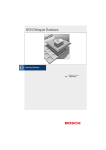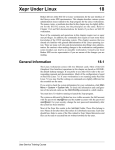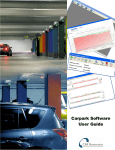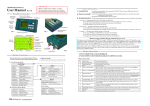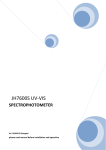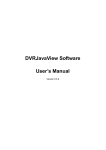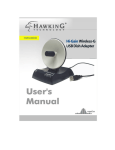Download Bosch Appliances Home Theater Screen LBB 3584 User's Manual
Transcript
DCN Video Display Security Systems Software User Manual en LBB 3584 VIDEO DISPLAY Video Display Software User Manual Digital Congress Network Page 2 VIDEO DISPLAY CONTENTS Title Page 1 - ABOUT VIDEO DISPLAY . . . . . . . . . . . . . . . . . . . . . . . . 5 1.1 What is Video Display? . . . . . . . . . . . . . . . . . . . . . . . . . . . .5 2 - VD CLIENT INSTALLATION . . . . . . . . . . . . . . . . . . . . .7 2.1 Introduction . . . . . . . . . . . . . . . . . . . . . . . . . . . . . . . . . . . .7 2.2 On the DCN Operator PC . . . . . . . . . . . . . . . . . . . . . . . .7 2.3 On another PC . . . . . . . . . . . . . . . . . . . . . . . . . . . . . . . . . .7 3 - STARTING AND EXITING VIDEO DISPLAY AND VD CLIENT . . . . . . . . . . . . . . . . . . . . . . . . . . . . . . .9 3.1 The Video Display icon . . . . . . . . . . . . . . . . . . . . . . . . . . .9 3.2 Exiting Video Display . . . . . . . . . . . . . . . . . . . . . . . . . . . . .9 3.3 Starting VD Client . . . . . . . . . . . . . . . . . . . . . . . . . . . . . .10 3.4 Exiting VD Client . . . . . . . . . . . . . . . . . . . . . . . . . . . . . . .10 4 - ALTERING VD CLIENT PARAMETERS . . . . . . . . . . . .11 4.1 Introduction . . . . . . . . . . . . . . . . . . . . . . . . . . . . . . . . . . .11 4.1 Overview . . . . . . . . . . . . . . . . . . . . . . . . . . . . . . . . . . . . .11 4.2 Screen settings . . . . . . . . . . . . . . . . . . . . . . . . . . . . . . . . .12 4.2.1 Screen texts . . . . . . . . . . . . . . . . . . . . . . . . . . . . . . . .13 4.2.2 Voting results . . . . . . . . . . . . . . . . . . . . . . . . . . . . . . .14 4.2.3 Screen turn over time . . . . . . . . . . . . . . . . . . . . . . . .15 4.3 Environment . . . . . . . . . . . . . . . . . . . . . . . . . . . . . . . . . . .15 4.4 Background bitmap . . . . . . . . . . . . . . . . . . . . . . . . . . . . . .16 4.5 Message setting . . . . . . . . . . . . . . . . . . . . . . . . . . . . . . . . .16 4.6 Screen line display . . . . . . . . . . . . . . . . . . . . . . . . . . . . . .16 4.7 Individual voting results . . . . . . . . . . . . . . . . . . . . . . . . . .16 4.8 Start-up window . . . . . . . . . . . . . . . . . . . . . . . . . . . . . . . .17 4.9 Blank screen background . . . . . . . . . . . . . . . . . . . . . . . . .17 4.10 Window switching . . . . . . . . . . . . . . . . . . . . . . . . . . . . . .17 Digital Congress Network Page 3 Video Display Software User Manual VIDEO DISPLAY 5 - DISPLAY CHARACTERISTICS . . . . . . . . . . . . . . . . . . .19 5.1 Introduction . . . . . . . . . . . . . . . . . . . . . . . . . . . . . . . . . . .19 5.2 Voting window . . . . . . . . . . . . . . . . . . . . . . . . . . . . . . . . .20 5.3 Attendance window . . . . . . . . . . . . . . . . . . . . . . . . . . . . .22 5.4 Message window . . . . . . . . . . . . . . . . . . . . . . . . . . . . . . . .23 5.5 Microphone window . . . . . . . . . . . . . . . . . . . . . . . . . . . .24 Video Display Software User Manual Digital Congress Network Page 4 VIDEO DISPLAY ABOUT VIDEO DISPLAY What is Video Display? The Video Display module is one of the DCN software modules designed to be used in conferences and discussions using the DCN contribution equipment. Its function is to interface the DCN software with conference video displays. The Video Display module provides a means of displaying conference-related information on video displays located in the conference venue. The information can consist of text, numbers and graphical elements like bar charts. All the information displayed is generated by other DCN modules, and it is not possible to alter this information in Video Display. NOTE: If information is to be displayed on video displays, data must be converted within the DCN control PC or transferred to a separate PC via an ethernet link. To use Video Display, it is necessary to have a Video Display (VD) Client application. The VD Client application receives the information which is passed to it from the Video Display (server) module. The user can change settings related to how information is displayed on the video screens, such as text or background colours. This can be carried out either during or after installation of the VD Client software. The VD Client application is supplied with the DCN installation disks. NOTE: It is not possible to use VD Client running on Windows 95 or 98 when Video Display is running on Windows NT 4.0 or Windows 2000. It is advisable to use the same operating system for both the VD Client and the Video Display server. NOTE: The VD Client must be started after the Video Display server has been started. NOTE: The source code for this application is supplied on the VD Client installation disks. It is therefore possible to alter this application using a Dynamic Data Exchange (DDE)-compatible package such as Visual Basic. Digital Congress Network Page 5 Video Display Software User Manual VIDEO DISPLAY This VD Client application accepts four different types of display information: • Voting Results display. This information is generated using the Parliamentary Voting module (LBB 3575) and the Multi Voting module (LBB 3576) and consists of a voting motion and the results of the vote on that motion. • Message display. This information is generated using the Message Distribution module (LBB 3582) and consists of a conference-related text message (e.g. when and where lunch will be, or when tomorrow’s session will begin). • Microphone Information display. This information is generated either using the Microphone Management module (LBB 3570) or the Synoptic Microphone Control module (LBB 3571). It consists of a list of delegates whose microphones are active and those waiting to speak. • Attendance registration display. This information is generated using the Attendance Registration module (LBB 3578). It consists of information about how many delegates are absent or present. NOTE: Display data can only be shown when the DCN software module which generates the data is running. For example, voting data can only be supplied when a voting application is active. NOTE: It is also possible to display DCN conference information using numeric displays, alphanumeric displays and geographic displays. For more information, please refer to the user manual for Text/Status Display (LBB 3583). Video Display is unlike all other DCN modules in that there is no user action required to operate it. It carries out its function - interfacing the DCN software with video displays - automatically. This document is therefore not a user manual but a reference manual. It gives information on default settings, installation and examples of typical displays containing microphone information, messages and voting results. NOTE: The DDE information which is available within the DCN system is described in the DCN External Interfaces document (3922 988 5101X). Video Display Software User Manual Digital Congress Network Page 6 VIDEO DISPLAY VD CLIENT INSTALLATION Introduction VD Client can be installed on the DCN operator PC as well as on another PC that has an Ethernet connection to the DCN operator PC. On the DCN Operator PC To install VD Client on the DCN operator PC: • Put the CD-ROM that contains the VD Client software in the CDROM drive of the PC. • Select the ‘Start’ button on the Windows Taskbar and click on ‘Run’. A dialogue box appears. • Type <D:\Video\Current\ClientSetup> in the ‘Open’ field and click on the ‘OK’ push button. If the CD-ROM drive has a letter assigned other than D, enter that letter in place of D. Follow the instructions that appear on-screen. On another PC Besides installing VD Client on the DCN Operator PC, it is also possible to install it on another PC that has a network connection to the DCN Operator PC. However, in that case an extra software application must be installed on the DCN Operator PC that takes care of the communication between Video Display and VD Client. The following requirements must be met for a correct operation of this application: • The TCP/IP protocol must have been installed on both PCs. • Both PCs must be in the same workgroup. • The IP address of the DCN Control PC must be 192.168.100.1. • The IP address of the VD Client PC must be 192.168.100.2. • The subnet mask of both PCs must be 255.255.255.0. • Put the CD-ROM that contains the VD Client software in the CDROM drive of the DCN Operator PC. • Select the ‘Start’ button on the Windows Taskbar and click on ‘Run’. Digital Congress Network Page 7 Video Display Software User Manual VIDEO DISPLAY A dialogue box appears. • Type <D:\Video\Current\ServerSetup> in the ‘Open’ field and click on the ‘OK’ push button. If the CD-ROM drive has a letter assigned other than D, enter that letter in place of D. Follow the instructions that appear on-screen. • Put the CD-ROM that contains the VD Client software in the CDROM drive of the VD Client PC. • Select the ‘Start’ button on the Windows Taskbar and click on ‘Run’. A dialogue box appears. • Type <D:\ClientSetup>in the ‘Open’ field and click on the ‘OK’ push button. If the CD-ROM drive has a letter assigned other than D, enter that letter in place of D. Follow the instructions that appear on-screen. Video Display Software User Manual Digital Congress Network Page 8 VIDEO DISPLAY STARTING AND EXITING VIDEO DISPLAY AND VD CLIENT The Video Display server is started from the DCN Startup screen of the PC that will act as DDE server. This is shown below: Fig. 1 - The DCN Startup screen. The Video Display icon For details on the Video Display icon and how to start Video Display from Startup, please refer to section 3.2 of the Startup user manual, under the heading ‘Opening other modules from Startup.’ Digital Congress Network Page 9 Video Display Software User Manual VIDEO DISPLAY Exiting Video Display To exit Video Display: • Click once with the right mouse button on the ‘Video’ icon. • Select ‘Close’ from the menu which appears. You will exit Video Display on the DDE server. Starting VD Client VD Client can be installed on the DCN operator PC as well as on another PC that has an Ethernet connection to the DCN operator PC. The procedure for starting VD Client depends on which PC the VD Clients software has been installed. If VD Client has been installed on the DCN Operator PC: • Start Video Display. • Select the ‘Start’ button on the Windows Taskbar and click on ‘Programs’. Then click ‘VD Client’ to start VD Client. If VD Client has been installed on another PC than the DCN Operator PC: • Start Video Display on the DCN Operator PC. • Select the ‘Start’ button on the Windows Taskbar of the DCN Operator PC and click on ‘Programs’. Then click ‘VD Server’ to start the application that enables communication between Video Display and VD Client. • Select the ‘Start’ button on the Windows Taskbar of the VD Client PC and click on ‘Programs’. Then click ‘VD Client’ to start the VD Client. Exiting VD Client To exit VD Client: • Press the <ESC> key of the VD Client PC. Video Display Software User Manual Digital Congress Network Page 10 VIDEO DISPLAY ALTERING VD CLIENT PARAMETERS Introduction The VD Client parameters can be configured either during installation or, at any time, by pressing the <F12> function key. In both cases, the ‘Configuration window’ is displayed, which provides access to all VD Client parameters. Overview The next screen shows the ‘Configuration window’ of VD Client. Fig. 2 - Configuration window. Digital Congress Network Page 11 Video Display Software User Manual VIDEO DISPLAY The configuration windows contains the following blocks of parameters: • Screen parameters (‘Screen Settings’). • Environment parameters (‘Environment’). • Background bitmap parameters (‘Background bitmap’). • Message parameters (‘Message setting’). • Screen line parameters (‘Screen line display’). • Individual voting result parameters (‘Individual Voting results’). • Start-up window parameters (‘Start-up window’). • Blank screen parameters (‘Blank screen background’). • Window switching parameters (‘Window switching’). Screen settings Using the ‘Screen settings’ block, the fonts and appearances of the headers, footers and delegate information displayed in the Voting, Attendance, Message and Microphone windows (see the next chapter) are configured: • Use the ‘Font’ buttons to choose the fonts in which a text must be displayed. • If borders must be displayed around texts, put a checkmark in the ‘Borders visible’ boxes and use the ‘Colour’ buttons to specify the colours of the borders. • Use the ‘Background’ button to change the colour of the background. • Use the ‘Foreground’ button to change the colour of the texts. Video Display Software User Manual Digital Congress Network Page 12 VIDEO DISPLAY Screen texts The ‘Screen text’ button provides access to the ‘Screen text editor’ (see the next figure). By default, all information in headers and footers is displayed in English. Using the ‘Screen text editor’, it is possible to translate these texts in another language. Fig. 3 - Screen text editor. Digital Congress Network Page 13 Video Display Software User Manual VIDEO DISPLAY Voting results The ‘Voting colours’ button provides access to the ‘Voting colours’ window (see the next figure). In this window, the colours for displaying the voting results are configured. Fig. 4 - Voting colours window. Using the ‘Parliamentary voting setting’ block, the colours for displaying the results of a parliamentary voting in the Voting window (see the next chapter) are configured. • Use the ‘Yes colour’ button to specify the colour for the “Yes” results. • Use the ‘No colour’ button to specify the colour for the “No” results. • Use the ‘Abstain colour’ button to specify the colour for the “Abstain” results. • Use the ‘Not voted’ button to specify the colour for the “Not voted” results. Video Display Software User Manual Digital Congress Network Page 14 VIDEO DISPLAY Using the ‘Multiple voting setting’ block, the colours for displaying the results of a multiple voting in the Voting window (see the next chapter) are configured. • Use the ‘Answer A/--’ button to specify the colour for the first answering option. • Use the ‘Answer B/-’ button to specify the colour for the second answering option. • Use the ‘Answer C/0’ button to specify the colour for the third answering option. • Use the ‘Answer D/+’ button to specify the colour for the fourth answering option. • Use the ‘Answer E/++’ button to specify the colour for the fifth answering option. Screen turn over time The ‘Screen turn over time’ slider configures the screen turn over time when a window contains more information than can be displayed on one screen. For example, the Attendance window can display 10 lines of information. When there are more delegates in the conference, the Attendance window consists of multiple screens that are each diaplayed for the configured time. Environment Using the ‘Environment’ block, the environment in which VD Client is running can be configured. VD Client runs either on the DCN operator PC or on an external PC with a network connection to the DCN operator PC. • If VD Client is running on an external PC, click the ‘Program runs on an external PC’ radio button and enter the network name of the DCN operator PC in the ‘Network name of DCN PC’ field. • If VD Client is running on the DCN operator PC, click the ‘Program runs on DCN Operator PC’ radio button. If the DCN operator PC has a dual video card, it is possible to use one video channel to display the DCN software modules and one video channel to display VD Client (tested for Matrox dualhead G550 video card). Digital Congress Network Page 15 Video Display Software User Manual VIDEO DISPLAY Background bitmap Using the ‘Background bitmap’ block, bitmaps (*.bmp or *.jpg) that are displayed on the background of the Voting, Attendance, Message or Microphone windows are defined. The bitmaps must have the same size as the desktop area of the PC that runs VD Client (min. 800 x 600 pixels, max. 1280 x 1024 pixels). Furthermore, the bitmap must be present in the VD Client directory and always contain the correct file extension (*.bmp or *.jpg). Message setting Using the ‘Message setting’ block, the font for displaying messages in the Message window (see the next chapter) is configured. • Use the ‘Message font’ button to choose the font for the messages. Screen line display Using the ‘Screen line display’ block, the layout for displaying delegate information is configured. The delegate information originates from the LBB3580 Delegate Database software module and consists of 30 characters divided over two fields. • The position of the slider must reflect the settings entered in the ‘Configure Screen Line’ window of the LBB3580 Delegate Database software module. • If only the first field of information must be displayed, click the ‘Display item 1’ radio button. • If only the second field of information must be displayed, click the ‘Display item 2’ radio button. • If both fields of information must be displayed, click the ‘Display both items’ radio button and enter the character that must be used to separate the fields in the ‘Separation character’ field. Individual voting results Using the ‘Individual Voting results’ block, it is possible to configure the contents of the individual voting screens: • If the names of all delegates must be shown, choose ‘Always show all names’. • If only the names of the delegates that are present and have voted must be shown, choose ‘Only show present/voted’. Video Display Software User Manual Digital Congress Network Page 16 VIDEO DISPLAY Start-up window Using the ‘Start-up window block’, the start-up window of VD Client is configured. VD Client provides the following windows: Voting, Attendance, Message and Microphone (see the next chapter). • If the start-up window must be the Blank screen, select ‘Idle window’. • If the start-up window must be the Voting window, select ‘Voting window’. • If the start-up window must be the Attendance window, select ‘Attendance window’. • If the start-up window must be the Message window, select ‘Message window’. • If the start-up window must be the Microphone window, select ‘Microphone window’. Blank screen background Using the ‘Blank screen background’ block, the background of the Blank screen is configured. See the next section for information about the Blank screen. • If the background must have the same colour as specified in the ‘Screen setting’ block, select ‘Colour as set in Screen setting’. • If the background must be black, select ‘Black’. Window switching Using the ‘Window switching’ block, the window switching mode can be configured. VD Client provides the following windows: Voting, Attendance, Message and Microphone. These windows can be switched either manually using function keys (see the next figure) or automatically. In the automatic window switching mode, VD client always switches to the window that was updated most recently. • If the windows must only be switched manually using function keys, click the ‘Function keys’ radio button. • If the windows must only be switched automatically, click the ‘Function keys & automatic’ button. It then still is possible to switch the windows using the function keys. • If a Blank screen must be shown after a certain time of inactivity, put a checkmark in the ‘Blank screen after secs of inactivity’ and define the number of seconds in the textbox. Digital Congress Network Page 17 Video Display Software User Manual VIDEO DISPLAY Fig. 5 - Help window. Note: This help window can be opened by pressing the <?> key. When the option ‘Function keys & automatic’ is selected, two lists appear to define priorities for the application windows. The ‘Application’ list shows the names of the application windows (i.e. Voting, Attendance, Message and Microphone), whereas the ‘Priority’ list shows the priorities for the application windows. (The window with the highest priority is on top of the ‘Priority’ list.). Double click an application window name to add it to the priority list. Video Display Software User Manual Digital Congress Network Page 18 VIDEO DISPLAY DISPLAY CHARACTERISTICS Introduction The VD Client application provides the means to show conference-related information on video displays located in the conference venue. This information can consist of text, numbers and graphical elements such as bar charts. The data for information displayed is generated by other DCN modules, and it is not possible to alter this information in VD Client. The VD Client provides the following windows: • Voting window • Attendance window • Message window • Microphone window Note: Customised VD Client applications can be made on request. For example, a VD Client application that contains a synoptic representation individual voting results (see the next figure). Fig. 6 - Voting window (synoptic). Digital Congress Network Page 19 Video Display Software User Manual VIDEO DISPLAY Voting window The Voting window displays voting information coming from the LBB3575 Parliamentary Voting and LBB3576 Multi Voting software modules. Voting information can be displayed in textual form as well as in graphical form (see the next figures for an example). Fig. 7 - Voting window (text). Video Display Software User Manual Digital Congress Network Page 20 VIDEO DISPLAY Fig. 8 - Voting window (graphical). Digital Congress Network Page 21 Video Display Software User Manual VIDEO DISPLAY Attendance window The Attendance window (see the next figure for an example) displays attendance information coming from the LBB3578 Attendance Registration software module. Fig. 9 - Attendance window. Video Display Software User Manual Digital Congress Network Page 22 VIDEO DISPLAY Message window The Message window (see the next figure for an example) displays messages coming from the LBB3582 Message Distribution software module. Fig. 10 - Message window. Digital Congress Network Page 23 Video Display Software User Manual VIDEO DISPLAY Microphone window The Microphone window (see the next figure for an example) displays microphone status information (speakers, request and last request) coming from the LBB3570 Microphone Management software module. Fig. 11 - Microphone window. Video Display Software User Manual Digital Congress Network Page 24 VIDEO DISPLAY Digital Congress Network Page 25 Video Display Software User Manual For more information please visit www.boschsecuritysystems.com © 2003 Bosch Security Systems B.V. Data subject to change without notice Nov. 03 | 3922 988 5051 15en


























